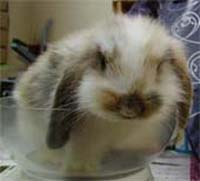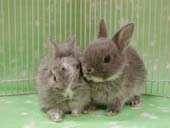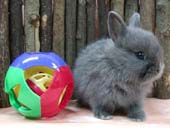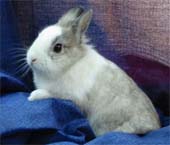RABBIT
 Am I the right pet for you?
Am I the right pet for you?
A rabbit will make a good pet for a family with a garden and enough time to give
it daily care and attention. Rabbits are more demanding than hamsters, gerbils
or guinea pigs and are not really suitable for very small children as they may
bite and scratch. However they are clean, intelligent and friendly and, if
properly looked after, can make rewarding company.
Each variety of rabbit has its own characteristics of size and temperament.
Males are often more predictable and even-tempered than females making them
ideal as pets. The food bill could be 10 times greater with a giant breed
compared to a dwarf and you will need much larger living quarters! Rabbits will
live for 6 - 8 years.
 Where did I come from?
Where did I come from?
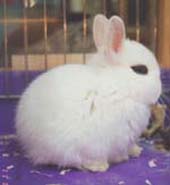
The gentle nature of the Rabbit has made it a popular pet for many years. In
addition to being easy to care for, petting the thick soft fur can ease stress
or provide comfort. Rabbits do not need walks, however, they can be
house-trained providing a nice alternative to the usual dog or cat.
Rabbits were originally bred for food and fur in the Middle Ages and used for
scientific research in the 20th century. Now a popular pet, they can be
categorised into three main groups based on their size: Dwarf's (2 to 4 pounds),
Standards (5 to 7 pounds) and Giants (7 to 15 pounds). Speciality groups, such
as lop-eared rabbits also exist.
Rabbits make fun pets as they are generally sociable, quiet and docile
creatures.
Rabbits have been on this planet for at least three and a half million years.
Their footprints have been found in Africa in fossilised lava dust. Rabbits are
found in the wild all over the world, even in Australia where they were
introduced last century and rapidly became pets.
Many varieties and colours of rabbits are available. Some of the more common
ones are Dutch, English and Netherland Dwarf. Dwarf lop-eared rabbits are very
popular because they are docile, intelligent and appealing to look at. Despite
their name they can grow quite large(5 to 7 lbs)but make ideal house rabbits.
Giant breeds should be avoided unless you have a lot of space and some of the
true dwarf varieties have a reputation for being bad tempered. The Angora has
long soft fur that requires a lot of grooming and is therefore not suitable for
children.
 Where do I like to live?
Where do I like to live?
You should choose a suitable location for the cage before you bring the animal
home.
■ Rabbit prefer cool temperatures ranging from 54 to 72 oF (12 to 22oC) although
they can tolerate temperature of up to 30oC.
■ Rabbits like bright and airy conditions but cannot tolerate the blazing sun.
Therefore, never place the cage close to a heater or in direct sunlight.
■ Large cages are most secure on the floor. If there is too much draft, place a
thick mattress under the pan or find a different area.
■ Rabbits have highly sensitive hearing. They do not appreciate a location where
they are exposed to a loud television, screaming pet birds, or continual human
traffic.
If your rabbit is kept outside, he should have a well insulated and
waterproof wooden hutch with a solid floor and wire front. Rabbits can also be
kept indoors in wire cages with perforated floors but solid bottom cages are
preferred. The hutch should be positioned out of direct sunlight and cold
draughts and in a place where you will regularly see him as rabbits love
attention and become lonely if isolated. The hutch should be as large as you can
afford or have space for.
There must be room for the rabbit to move around and it must be high enough for
him to stand up on his back feet. The hutch must also be well protected from
cats and dogs. Ideally, there should be a run either attached to the hutch or in
a separate part of the garden. If this is directly onto grass, it should be
moved regularly. A separate nest box can be put in the hutch and should contain
plenty of hay, straw or wood shavings.
 How to handle me?
How to handle me?
Once they are tamed, rabbits enjoy human company, but prefer to sit beside
you rather than being picked up. They love being rubbed or scratched gently on
the nose, muzzle and ears. To pick your rabbit up, place one hand under his
chest and forelegs and the other hand under his bottom and gently scoop him up,
holding him firmly, but gently, close to your body. Never grab at their rear
ends or pick them up by their ears.
 What do I like to eat?
What do I like to eat?
Fresh Timothy hay from American Pet Diner or Oxbow should form the basis of your
rabbits diet and must be supplemented with a good quality rabbit pellet or mix.
Totoro Supplies sell a range of high quality pellets that contain a balanced
amounts of protein, carbohydrate, vitamins and minerals. Fresh foods should only
be introduced to them slowly when they are 6 to 7 months old as supplement to
their diet. Small amounts of apples, cabbage or kale as well as edible wild
plants like dandelions, chickweed or clover may be fed but always remember to
wash them first. Young rabbits in particular can get upset stomachs quite easily
from too much green food or being allowed to eat too much grass. Papaya tablets
should also be introduce to them to prevent hair ball.
All rabbits must have fresh hay or forage available at all times but the amount
of rabbit mix will need to be varied according to your rabbits age. Rabbits over
about 6 months of age have a tendency to become overweight and therefore the
amount of rabbit mix they are given will need to be controlled. Your rabbit
should be checked regularly and fed at the same times each day. The food bowl
should be sturdy, difficult to knock over and preferably made from earthenware,
as rabbits will chew plastic. Water should always be available from a bottle.
Below are HARMFUL and POISONOUS plants to rabbits:
■ Creeping bitter-cup
■ Crocus (mixed)
■ Toadflax
■ Dogbane
■ Darnelgrass
■ Veratrum
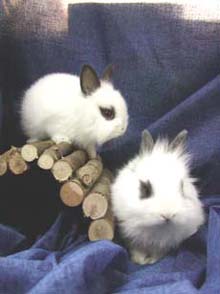
 Do I like company?
Do I like company?
Adult rabbits are best housed separately, as 2 males or 2 females will often fight and a pair will breed. It is possible to have rabbits neutered if you want to keep two rabbits of different sexes together without breeding. Neutering will also reduce the aggression between two rabbits of the same sex. Rabbits can get on well with your cat and dog if introduced slowly but always supervise them together. If you keep one rabbit on its own it will need much more of your time.
 Keeping me fit and healthy?
Keeping me fit and healthy?
Good nutrition and housing are the key to a healthy rabbit. Avoid sudden changes
in diet and temperature and keep beddings clean and dry. The hutch should be
clean daily and scrubbed out with warm water and a mild disinfectant at least
once a week. The feeding bowl and water bottle should be cleaned daily.
Rabbits' front teeth continue to grow throughout their lives and if they become
too long feeding can become difficult.
Mineral stones, good quality pellets, Timothy hay and chew toys all helps to
keep the teeth worn down. If the bottom teeth grow over the top teeth, take your
rabbit to the vet to have them trimmed. Rabbits are clean animals and will wash
themselves like cats. However rabbits love a daily grooming session and, for the
long fur varieties, such as Angoras, frequent grooming is essential to prevent
hairballs and to keep the coat shiny and clean.
There are several common rabbit diseases, most of which are contagious. If your
rabbit loses his appetite, appears listless, develops sniffles, runny eyes or
diarrhea, you should take him to your vet.
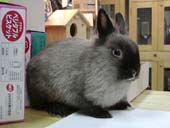
 Breeding
Breeding
■ Rabbits can breed or sexually mature at 12 weeks - 16 weeks old, depending on
the breed
■ They produce an average litter size of 4-12 rabbits, the larger breeds tending
to have the larger litters.
■ The length of pregnancy is shorter (28 to 31 days)
■ The young are born blind and hairless and should not be touched for 72 hours
■ The young rabbits eyes open at 8-10 days
■ They can only be removed from their mother at 5-8 weeks old..
